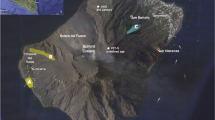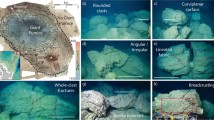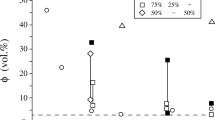Abstract
The explosion of a cryptodome at Mount St. Helens in 1980 produced two juvenile rock types that are derived from the same source magma. Their differences-color, texture and density-are due only to vesicularity differences. The vesicular gray dacite comprises bout 72% of the juvenile material; the black dacite comprises the other 28%. The density of juvenile dacite is bimodally distributed, with peaks at 1.6 g cm-3 (gray dacite) and 2.3 g cm-3 (black dacite). Water contents, deuterium abundances, and the relationship of petrographic structures to vapor-phase crystals indicate both rock types underwent pre-explosion subsurface vesiculation and degassing. The gray dacite underwent a second vesiculation event, probably during the 18 May explosion. In the subsurface, gases probably escaped through interconnected vesicles into the permeable volcanic edifice. We suggest that nonuniform degassing of an initially homogeneous magma produced volatile gradients in the cryptodome and that these gradients were responsible for the density bimodality. That is, water contents less than about 0.2–0.4 wt% produced vesicle growth rates that were slow in comparison to the pyroclast cooling rates; greater water contents produced vesicle growth rates that were fast in comparison to cooling rates. In this scheme, the dacite densities are bimodally distributed simply because, following decompression on 18 May 1980, one clast population vesiculated while the other did not. For clasts that did vesiculate, vesicle growth continued until it was arrested by fragmentation.
Similar content being viewed by others
References
Anderson SW, Fink JH (1989) Hydrogen-isotope evidence for extrusion mechanisms of the Mount St. Helens lava dome. Nature 341:521–523
Baedecker PA, McKown DM (1987) Instrumental neutron activation analysis of geochemical samples. In: Baedecker PA (ed) Methods for geochemical analysis. US Geol Surv Bull 1770:H1–H14
Banks NG, Hoblitt RP (1981) Summary of temperature studies of 1980 deposits. In: Lipman PW, Mullineaux DR (eds) The 1980 eruptions of Mount St. Helens, Washington. US Geol Surv Prof Pap 1250:295-313
Barnes I, Johnston DA, Evan WC, Presser TS, Mariner RH, White LD (1981) Properties of gases and waters of deep origin near Mount St. Helens. In: Lipman PW, Mullineaux DR (eds) The 1980 eruptions of Mount St. Helens, Washington. US Geol Surv Prof Pap 1250:233–237
Borthwick J, Harmon RS (1982) A note regarding ClF3 as an alternative to BrF5 for oxygen isotope analysis. Geochim Cosmochim Acta 46:1665–1668
Burnham WC (1979) Magmas and hydrothermal fluids. In: Barnes HL (ed) Geochemistry of hydrothermal ore deposits, second ed John Wiley & Sons, 71–136
Carey S, Sigurdsson H (1985) The May 18, 1980 eruption of Mount St. Helens 2. Modeling of dynamics of the plinian phase. J Geophys Res 90, B4:2948–2958
Casadevall TJ, Johnston DA, Harris DM, Rose WI Jr, Malinconico LL, Stoiber RE, Bornhorst TJ, Williams SN, Woodruff Laurel, Thompson JM (1981) SO2 emission rates at Mount St. Helens from March 29 through December, 1980. In: Lipman PW, Mullineaux DR (eds) The 1980 eruptions of Mount St. Helens, Washington. US Geol Surv Prof Pap 1250:193–200
Cashman KV (1988) Crystallization of Mount St.Helens 1980–1986 dacite: a quantitative textural approach. Bull Volcanol 50:194–209
Cashman KV (1992) Groundmass crystalization of Mount St. Helens dacite, 1980–1986: a tool for interpreting shallow magmatic processes. Contrib Mineral Petrol 109:431–449
Cashman KV, Taggart JE (1983) Petrologic monitoring of 1981 and 1982 eruptive products from Mount St. Helens. Science 221:1385–1387
Clayton RN, Mayeda TK (1963) The use of bromne petafluoride in the extraction of oxygen from oxides and silicates for isotopic analysis. Geochim Cosmochim Acta 27:43–52
Crandell DR (1987) Deposits of pre-1980 pyroclastic flows and lahars from Mount St. Helens volcano, Washington. US Geol Surv Prof Pap 1444:91pp
Dobson PF, Epstein S, Stolper EM (1989) Hydrogen isotope fractionation between coexisting vapor and silicate glasses and melts at low pressure. Geochim Cosmochim Acta 53:2723–2730
Druitt TH (1992) Emplacement of the 18 May 1980 lateral blast deposit ENE of Mount St. Helens, Washington. Bull Volcanol 54:554–572
Dzurisin D, Denlinger RP, Rosenbaum JG (1990) Cooling rate and thermal structure determined from progressive magnetization of the dacite dome at Mount St. Helens, Washington. J Geophys Res 95:2763–2780
Eichelberger JC, Hayes DB (1982) Magmatic model for the Mount St. Helens Blast of May 18, 1980. J Geophys Res 87:7727–7738
Eichelberger JC, Westrich HR (1983) Behaviour of water in rhyolitic magma at shallow depth. EOS 64:338
Eichelberger JC, Carrigan CR, Westrich HR, Price RH (1986) Non-explosive silicic volcanism. Nature 323:598–602
Evans WC, Banks NG, White LD (1981) Analysis of gas samples from the summit crater. In: Lipman PW, Mullineaux DR (eds) The 1980 eruptions of Mount St. Helens, Washington. US Geol Surv Prof Pap 1250:227–231
Fisher RV (1990) Transport and deposition of a pyroclastic surge across an area of high relief: The 18 May 1980 eruption of Mount St. Helens, Washington. Geol Soc Am Bull 102:1038–1054
Friedman I, Long W (1976) Hydration rate of obsidian. Science 191:347–352
Godfrey JD (1962) The deuterium content of hydrous minerals from the east-central Sierra Nevada and Yosemite National. Park. Geochim Cosmochim Acta 26:1215–1245
Graham CM, Harmon RS, Sheppard SMF (1984) Experimental hydrogen isotope studies: hydrogen isotope exchange between amphibole and water. Am Min 69:128–138
Halliday AN, Fallick AE, Dickin AP, Mackenzie AB, Stephens WE, Hildreth W (1983) The isotopic and chemical evolution of Mount St. Helens. Earth Planet Sci Lett 63:241–256
Harmon RS, Hoefs J (1986) S-isotope relationships in Late Cenozoic destructive plate margin and continental intraplate volcanic rocks [abs]. Terra Cognita 6:182
Harmon RS, Hoefs J, Wedepohl KH (1987) Stable isotope (O,H,S) relationships in Tertiary basalts and their mantle xenoliths from the Northern Hessian Depression, W. Germany. Contrib Mineral Petrol 95:350–369
Heliker C (in press) Inclusions in Mount St. Helens dacite erupted from 1980 through 1983. J Volcanol Geotherm Res.
Hoblitt RP, Crandell DR, Mullineaux DR (1980) Mount St. Helens eruptive behaviour during the past 1,500 yr. Geology 8:555–559
Hoblitt RP, Miller CD, Vallance JW (1981) Origin and stratigraphy of the deposit produced by the May 18 directed blast. In: Lipman PW, Mullineaux DR (eds) The 1980 eruptions of Mount St. Helens, Washington. US Geol Surv Prof Pap 1250:401–419
Holdaway MJ, Dutrow BL, Borthwick J, Shore P, Harmon RS, Hinton RW (1986) Staurolite water content as determined by hydrogen extraction line and ion microprobe. Am Min 71:1135–1141
Ingersoll LR, Zobel OJ, Ingersoll AC (1948) Heat conduction: with engineering and geological applications. First Ed. McGraw-Hill NY
Kokelaar BP (1982) Fluidization of wet sediments during the emplacement and cooling of various igneous bodies. J Geol Soc London 139:21–33
Kuntz MA, Rowley PD, MacLeod NS, Reynolds RL, McBroome LA, Kaplan AM, Lidke DJ (1981) Petrography and particlesize distribution of pyroclastic-flow, ash-cloud, and surge deposits. In: Lipman PW, Mullineaux DR (eds) The 1980 eruptions of Mount St. Helens, Washington. US Geol Surv Prof Pap 1250:525–539
Lipman PW, Norton DR, Taggart Jr JE, Brandt EL, Engleman EE (1981) Compositional variations in 1980 magmatic deposits. In: Lipman PW, Mullineaux DR (eds) The 1980 eruptions of Mount St. Helens, Washington. US Geol Surv Prof Pap 1250:631–640
Melson WG (1983) Monitoring the 1980–1982 eruptions of Mount St. Helens: compositions and abundances of glass. Science 221:1387–1391
Merzbacher C, Eggler DH (1984) A magmatic geohygrometer: application to Mount St. Helens and other dacitic magmas. Geology 12:587–590
Moore JG, Albee WC (1981) Topographic and structural changes, March-July 1980-photogrammetric data. In: Lipman PW, Mullineaux DR (eds) The 1980 eruptions of Mount St. Helens, Washington. US Geol Surv Prof Pap 1250:123–134
Moore JG, Sisson TW (1981) Deposits and effects of the May 18 pyroclastic surge. In: Lipmann PW, Mullineaux DR (eds) The 1980 eruptions of Mount St. Helens, Washington. US Geol Surv Prof Pap 1250:421–438
Murase T, McBirney AR (1973) Properties of some common igneous rocks and their melts at high temperatures. Geol Soc Am Bull 84:3563–3592
Newman S, Epstein S, Stolper E (1988) Water, carbon dioxide, and hydrogen isotopes in glasses from the ca. 1340 A.D. eruption of the Mono Craters, California: constraints on degassing phenomena and initial volatile content. J Volcanol Geotherm Res 35:75–96
Pallister JS, Hoblitt RP, Crandell DR, Mullineaux DR (1992) Mount St. Helens a decade after the 1980 eruptions: magmatic models, chemical cycles, and a revised hazards assessment. Bull Volcanol 54:126–146
Rutherford MJ, Devine J (1986) Experimental petrology of recent Mount St. Helens dacites: amphibole, Fe-Ti oxides and magma chamber conditions. Geol Soc Am Abstracts with Programs 16:641
Rutherford MJ, Devine JD (1988) The May 18, 1980, eruption of Mount St. Helens 3. Stability and chemistry of amphibole in the magma chamber. J Geophys Res 93:11,949–11,959
Rutherford MJ, Sigurdsson H, Carey S, Davis A (1985) The May 18, 1980 eruption of Mount St. Helens 1. Melt composition and experimental phase equilibria. J Geophys Res 90:2929–2947
Sasaki A, Arikawa F, Folinsbee RE (1979) Kiba reagent method of sulfur extraction applied to isotopic work. Bull Geol Surv Japan 30:241–245
Scandone R, Malone SD (1985) Magma supply, magma discharge and readjustment of the feeding system of Mount St. Helens during 1980. J Volcanol Geotherm Res 23:239–262
Silver LA, Ihinger PD, Stolper EM (1990) The influence of bulk composition on the speciation of water in silicate glasses. Contrib Mineral Petrol 104:142–162
Sparks RSJ (1978) The dynamics of bubble formation and growth in magmas: a review and analysis. J Volcanol Geotherm Res 3:1–37
Stolper E (1989) The speciation of water in silicate melts. Geochim Cosmochim Acta 46:2609–2620
Taggart JE, Lindsay JR, Scott BA, Vivit DV, Bartel AJ, Stewart KC (1987) Analysis of geologic materials by X-ray fluorescence spectrometry. In: Baedecker PA (ed) Methods for geochemical analysis. US Geol Surv Bull 1770:E1-E19
Taylor BE, Eichelberger JC, Westrich HR (1983) Hydrogen isotopic evidence of rhyolitic magma degassing during shallow intrusion and eruption. Nature 306:541–545
Taylor HP, Sheppard SMF (1986) Igneous rocks: 1. Processes of fractionation and isotopic systematics. In: Valley JW, Taylor HP, O'Neil JR (eds) Stable isotopes in high temperature geological processes. Rev Mineral 16:227–269
Thompson JM, White LD, Casadevall TJ, Maley CA, Keith TEC (1985) Hot springs depositing travertine at Mount St. Helens. EOS 66:1154
Ueda A, Sakai H (1984) Sulfur isotope study of Quaternary volcanic rocks from the Japanese Islands Arc. Geochim Cosmochim Acta 48:1837–1448
Voight B (1981) Time scale for the first moments of the May 18 eruption. In: Lipman PW, Mullineaux DR (eds) The 1980 eruptions of Mount St. Helens, Washington. US Geol Surv Prof Pap 1250:69–86
Author information
Authors and Affiliations
Rights and permissions
About this article
Cite this article
Hoblitt, R.P., Harmon, R.S. Bimodal Density Distribution of Cryptodome Dacite from the 1980 Eruption of Mount St. Helens, Washington. Bull Volcanol 55, 421–437 (1993). https://doi.org/10.1007/BF00302002
Received:
Accepted:
Issue Date:
DOI: https://doi.org/10.1007/BF00302002




